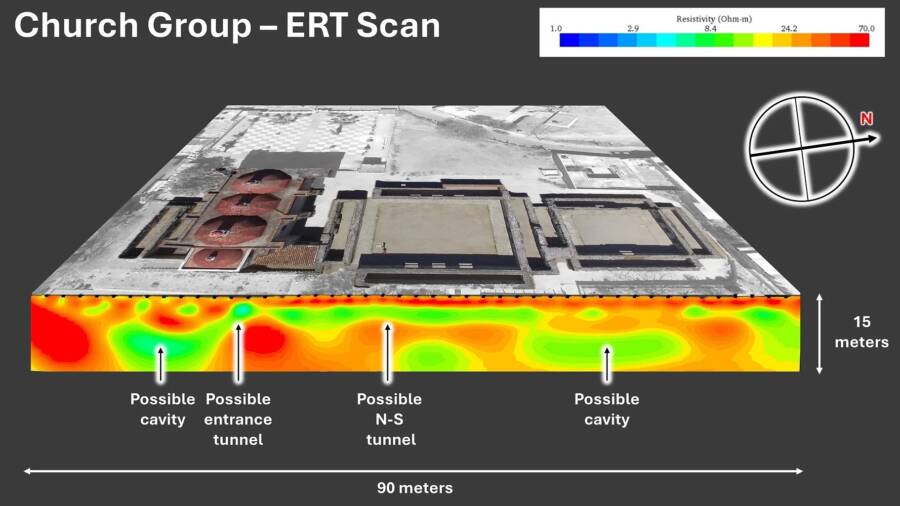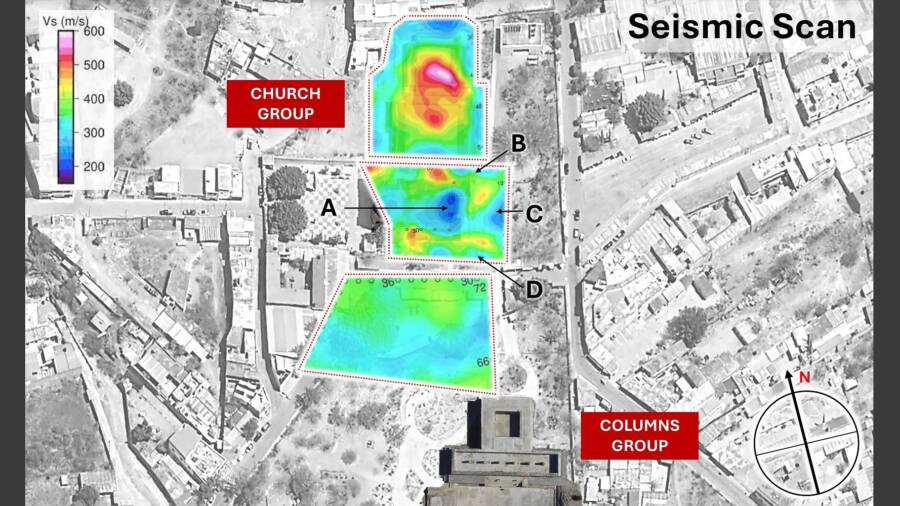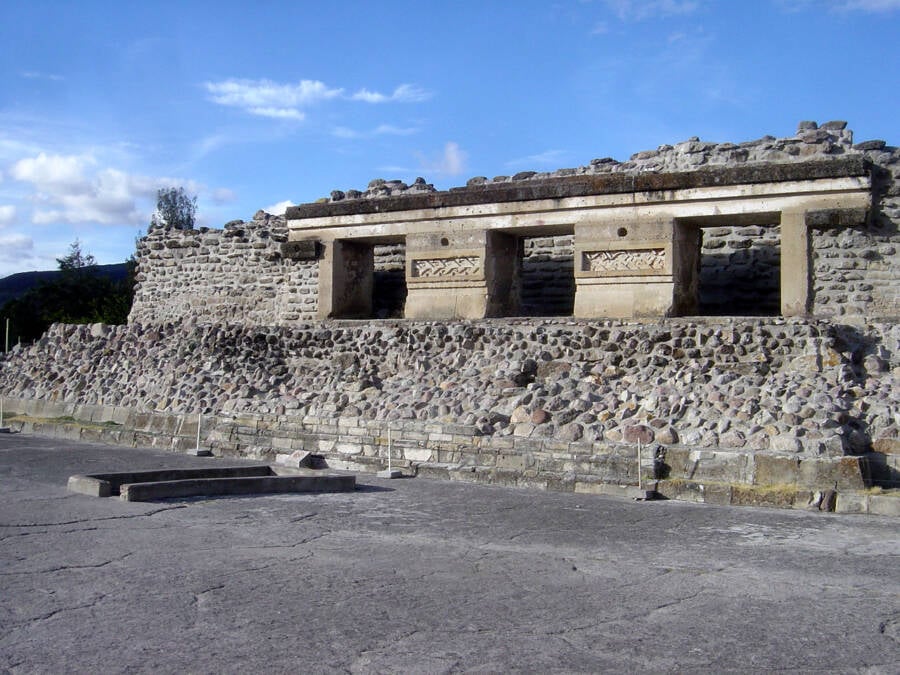It's long been believed that the ancient city of Mitla in Mexico sat over tunnels to the underworld — and archaeologists are getting closer to proving that such tunnels actually exist.

Dr. Andrés Tejero Andrade/UNAM. Elaboration: Marco M. Vigato/ARX ProjectThe search for the “underworld” in Mitla is ongoing, and the newest research has returned some exciting results.
The Zapotec people believed they knew where to find the underworld: beneath their feet in the ancient Mexican city of Mitla. The existence of caverns and chambers under the town — and under the Church of San Pablo Apostol — was dutifully recorded by a 17th-century friar, but modern researchers have been unable to locate them. Now, however, archaeologists are getting closer to proving that such a labyrinth actually exists.
The ARX Project, in collaboration with the National Institute of Anthropology and History of Mexico (INAH), is using new technology to unlock the town’s ancient secrets. The team has started to document evidence of tunnels beneath Mitla, the city that the Zapotecs knew as “the place of the dead.”
The ‘Underworld’ Tunnels Discovered In Mitla

Mechitas/Wikimedia CommonsThe Church of San Pablo Apostol, which is located at the Mitla archaeological site.
As Project ARX recently published on their website, the results of their 2023 investigation seem extremely promising. The team used “ground penetrating radar, electric, and seismic tomography” in order to confirm “the existence of a network of previously undiscovered subterranean chambers and passageways” at the archaeological site of Mitla in Mexico.
Their findings build on the previous year’s research at the site, which revealed “a large void underneath the [Church of San Pablo Apostol].” Now, the archaeologists have confirmed the earlier results and expanded their search area to other locations. So far, it’s been a fruitful project.
“The 2023 results confirm the existence of significant underground anomalies (tunnels or chambers) under the Church Group of the archaeological site, in the location where colonial accounts and local oral traditions claim the entrance to Mitla’s subterranean labyrinth was located,” Project ARX Founder Marco Vigato told All That’s Interesting.

Project ARXArchaeologists using non-invasive techniques to search for the “underworld” in Mitla, which was described by both ancient people and foreigners over the centuries.
He continued: “Additionally, the 2023 research season significantly expanded the area studied with geophysical methods, to include the Adobe Group, Arroyo Group, and South Group of the archaeological site. In all these groups, significant geophysical anomalies were detected, which may correspond to underground cavities such as tombs or passageways.”
Indeed, the recent findings — which Project ARX has compiled into a short documentary — seem to confirm long-held beliefs that Mitla was built atop an underground labyrinth. The Zapotec people believed that these snaking tunnels were an entrance to the underworld.
‘The Place Of The Dead’: The Enduring Legend Of The Underworld In Mitla

Dr. Martin Cardenas Soto/UNAM. Elaboration: Marco M. Vigato/ARX ProjectA seismic scan of Mitla.
The Zapotec people emerged some 2,500 years ago and established a settlement at Mitla around 900 C.E. Mitla became known as “the place of the dead,” and ancient Mesoamerican people believed that the cavernous tunnels and caves beneath the city led to the underworld, known as Lyobaa. Because of this, Mitla became a burial ground for Zapotec kings and high priests.
When the Spanish arrived in the 16th century, they tore down ancient buildings in order to construct a Catholic church. The Church of San Pablo Apostol was thus built on the ruins of the Zapotec’s most sacred temple.
Still, rumors of the underworld endured.
In the 17th century, when Father Francisco de Burgoa visited the site, he documented what he had seen and learned. The city, he wrote, sat above a subterranean labyrinth, which included underground chambers that were used as crypts for high priests and kings. It also contained an especially deep chamber where the Zapotec threw human sacrifices.
But Burgoa alleged that the Spanish had sealed these chambers.

Wikimedia CommonsRuins at Mitla, the city that ancient people knew as the “place of the dead.”
“Curious and zealous men and prelates attempted to dispel these ignorant beliefs,” Burgoa explained. “They descended through some steps with many people, carrying lit torches and lamps, until they encountered numerous buttresses resembling streets… The stench and foul odor were as strong as the dampness of the ground, with a cold air that extinguished their lights. After a short distance, fearing being afflicted or encountering poisonous creatures (of which they saw some), they decided to retreat. They commanded to seal that infernal doorway completely, yet the upper rooms, with their courtyard and chambers, still remain.”
The search for the underworld in Mitla began in the 19th century, but it’s only been in recent years that archaeologists have found clues to its existence. Based on the most recent scans, it does seem that there’s something beneath Mitla — a “void.” But what does it contain?
Vigato and his team are hoping to find out.
“We are working on a research proposal for the Mexican National Institute of History and Anthropology (INAH) involving minimally destructive excavations aimed at confirming the nature, size, depth, and orientation of the geophysical anomalies identified,” Vigato explained to All That’s Interesting. “In some cases, it may be possible to drill small test holes to insert a small camera. All the findings from the geophysical study will have to be confirmed with archaeological methods.”
Though the royal and religious tombs may have been looted by colonizers, Vigato suspects that “they may still contain important evidence of Zapotec funerary practices and beliefs concerning the underworld.” What’s more, if ancient people modified the natural caves in Mitla, they “may contain a continuous sequence of human occupation and rituals” from ancient times that could help answer questions “concerning the origins of Mitla as a ceremonial center and the connection between Mitla, Monte Alban, and other early Zapotec centers in the valley of Tlacolula and Oaxaca.”
As such, the search for the underworld continues.
After reading about the rumored “underworld” beneath the ancient Mexican city of Mitla, discover the story of Mictlantecuhtli, the Aztec god of death and the underworld. Or, go inside the disturbing myth of Hades and Persephone.





